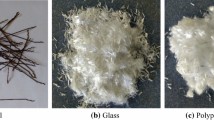Abstract
Reinforcing geopolymer materials with fibers can enhance tensile and flexural strengths and fracture toughness. The bond between fiber and geopolymer matrix is a critical factor that needs to be investigated to optimize the performance of the fiber reinforced composite. In this study, single fiber pull-out tests are conducted on steel and polypropylene fibers embedded in geopolymer matrices; in addition, OPC mortars are tested as control condition. The following parameters are investigated: fiber type (i.e. steel and polypropylene) and shape, concentration of alkali solution in the geopolymer matrix, and curing conditions. Bond-slip performance, failure modes, and slip resisting mechanisms of different matrices and fibers are compared and discussed. The fiber deformation ratio, a novel parameter, is introduced to quantitatively investigate the effect of fiber shape on the mortar performance. In case of steel fibers, the geopolymer-fiber composite performs better for lower fiber deformation ratios, where the full fiber pull-out mechanism can be exploited. For higher deformation ratios, the strong bearing forces developed, combined with the high adhesion strength of the geopolymer-steel fiber interface, lead to more brittle failure mechanisms, such as fiber breakage or matrix failure, as observed in end-deformed and length-deformed steel fibers, respectively.









Similar content being viewed by others
References
Hendriks CA, Worrel E, De Jager D, Blok K, Riemer P (1998) Emission reduction of greenhouse gases from the cement industry. In: Proceedings of the fourth international conference on greenhouse gas control technologies, 30 Aug–2 Sept, Interlaken, 939–944
World Buisness Council for Sustainable Development (2012) The cement sustainability initiative. 10 years of progress—moving on to the next decade. http://www.wbcsdcement.org/
Hardjito D, Wallah SE, Sumajouw DMJ, Rangan BV (2004) On the development of fly ash-based geopolymer concrete. ACI Mater J 101(6):467–472
Davidovits J (1997) Geopolymers—inorganic polymeric new materials. J Therm Anal 37(8):1633–1656
Wastiels J, Wu X, Faignet S, Patfoort G (1994) Mineral polymer based on fly ash. J Resour Manag Technol 22:135–141
Provis J, Van Deventer J (2014) Alkali activated materials: state-of-the-art report. RILEM TC 224-AAM, Springer
Palomo A, Grutzeck MW, Blanco MT (1999) Alkali-activated fly ashes: a cement for the future. Cem Concr Res 29:1323–1329
Alomayri T, Shaikh FUA, Low IM (2014) Synthesis and mechanical properties of cotton fabric reinforced geopolymer composites. Compos B Eng 60:36–42
Dias DP, Thaumaturgo C (2005) Fracture toughness of geopolymeric concretes reinforced with basalt fibers. Cement Concr Compos 27(1):49–54
Ohno M, Li VC (2014) A feasibility study of strain hardening fiber reinforced fly ash-based geopolymer composites. Constr Build Mater 57:163–168
Nematollahi B, Sanjayan J, Shaikh FUA (2014) Comparative deflection hardening behavior of short fiber reinforced geopolymers composites. Constr Build Mater 70(15):54–64
Shaikh FUA (2013) Review of mechanical properties of short fiber reinforced geopolymer composites. Constr Build Mater 43(15):37–49
Shaikh FUA (2013) Deflection hardening behavior of short fiber reinforced fly ash based geopolymer composites. Mater Des 50:674–682
Bernal S, Gutierrez RD, Delvasto S, Rodriguez E (2010) Performance of an alkali-activated slag concrete reinforced with steel fibers. Constr Build Mater 24:208–214
Puertas F, Amat T, Fernandez-Jimenez A, Vazquez T (2013) Mechanical and durable behavior of alkaline cement mortars reinforced with polypropylene fibers. Cem Concr Res 33:2031–2036
Wongpa J, Kiattikomol K, Jaturapitakkul C, Chindaprasirt P (2010) Compressive strength, modulus of adhesionality and water permeability of inorganic polymer concrete. Mater Des 31:4748–4754
Sarker K, Haque R, Ramgolam KV (2013) Fracture behavior of heat cured fly ash based GP concrete. Mater Des 44:580–586
Sakulich AR (2011) Reinforced GP composites for enhanced material greenness and durability. Sustain Cities Soc 1(4):195–210
ASTM Standard (2005) C 618, Standard specification for coal fly and raw or calcined natural pozzolan for use as mineral admixture in concrete, Annual Book of ASTM Standards. ASTM International, West Conshohocken
Hussin MW, Bhutta MAR, Azreen M, Mahmood MT (2015) Performance of blended ash geopolymer concrete at elevated temperatures. Mater Struct 48(3):709–720
Banthia N (1990) A study of some factors affecting the fiber-mortar bond in steel fiber reinforced concrete. Can J Civ Eng 17:610–620
ASTM C39/C39M (2015) Standard test method for compressive strength of cylindrical concrete specimens
ASTM C496/C496M (2011) Standard test method for splitting tensile strength of cylindrical concrete specimens
Banthia N, Krishnadev MR (1990) Steel-fiber cementitious mortar load relaxation studies using a screw-driven testing machine. Exp Tech 42:41–43
Li Z, Mobasher B, Shah S (1991) Characterization of interfacial properties in fiber reinforced cementitious composites. J Am Ceram Soc 74(9):2156–2164
Redon C, Li VC, Wu C, Hoshiro H, Saito T, Ogawa A (2001) Measuring and modifying interface properties of PVA fibers in ECC mortar. J Mater Civ Eng 13(6):399–406
Singh B, Ishwarya G, Gupta M, Bhattacharyya SK (2015) Geopolymer concrete: a review of some recent developments. Constr Build Mater 85:78–90
Pachego-Torgal F, Castro-Gomes J, Jalali S (2008) Alkali-activated binders: a review, Part 1. Constr Build Mater 22:1305–1314
Lee WKW, Van Deventer JSJ (2004) The interface between natural siliceous aggregates and geopolymers. Cem Concr Res 34(2):195–206
Zhang YS, Sun W, Li JZ (2005) Hydration process of interfacial transition in potassium polysialate (K-PSDS) geopolymer concrete. Mag Concr Res 57(1):33–38
Yong SL, Feng DW, Luckey GC, Van Deventer JSJ (2007) Chemical characterization of the steel-geopolymeric gel interface. Colloids Surf A 302(1–3):411–423
Kim DJ, El-Tawil S (2009) Rate-dependent tensile behavior of high performance fiber reinforced cementitious composites. Mater Struct 42:399–414
Xu H, Van Deventer JSJ (2000) The geopolymerization of alumino-silicate minerals. Int J Miner Process 59:247–266
Armelin HS, Banthia N (1997) Predicting the flexural post-cracking performance of steel fiber reinforced concrete from the pullout of Single Fibers. ACI Mater J 94(1):18–31
Acknowledgments
The authors wish to acknowledge the financial support of Canada-India Research Center of Excellence (IC-IMPACTS). The assistance of Jane Wu (Department of Civil Engineering, Faculty of Applied Science, University of British Columbia) during the SEM samples preparation and analysis is appreciated.
Author information
Authors and Affiliations
Corresponding author
Rights and permissions
About this article
Cite this article
Bhutta, A., Farooq, M., Zanotti, C. et al. Pull-out behavior of different fibers in geopolymer mortars: effects of alkaline solution concentration and curing. Mater Struct 50, 80 (2017). https://doi.org/10.1617/s11527-016-0889-2
Received:
Accepted:
Published:
DOI: https://doi.org/10.1617/s11527-016-0889-2




